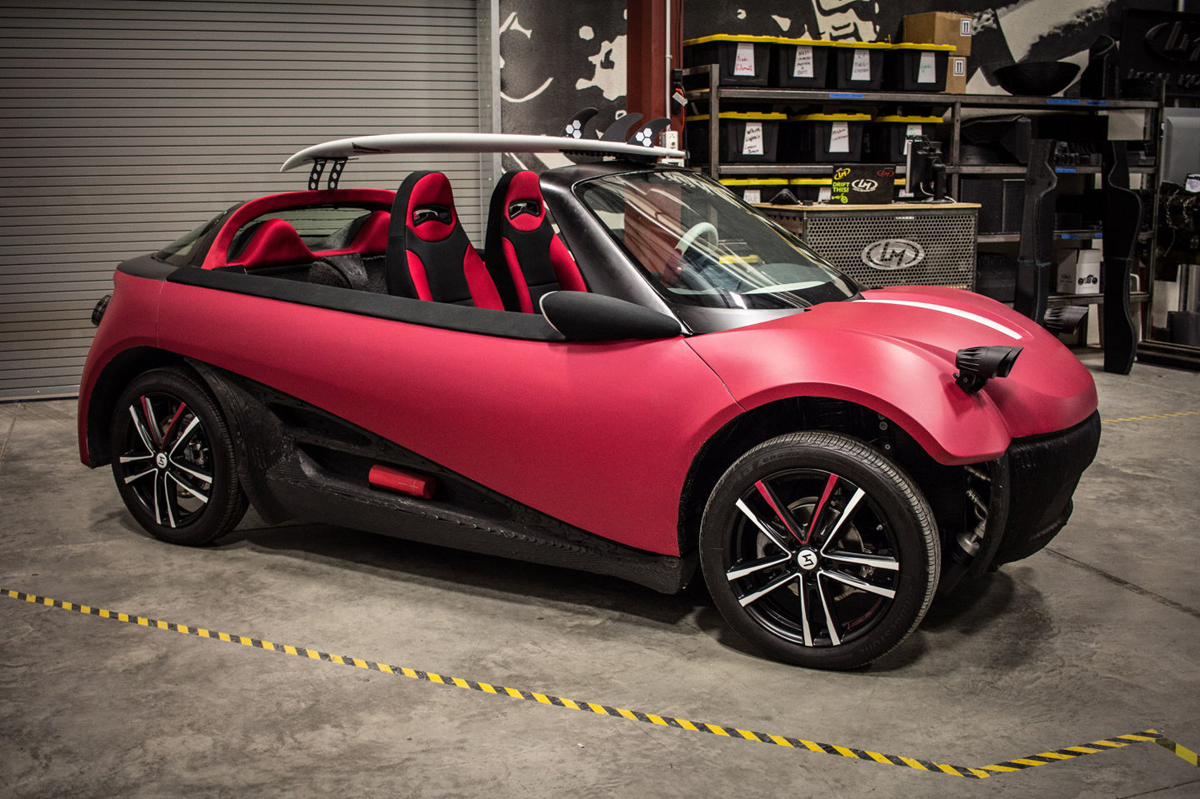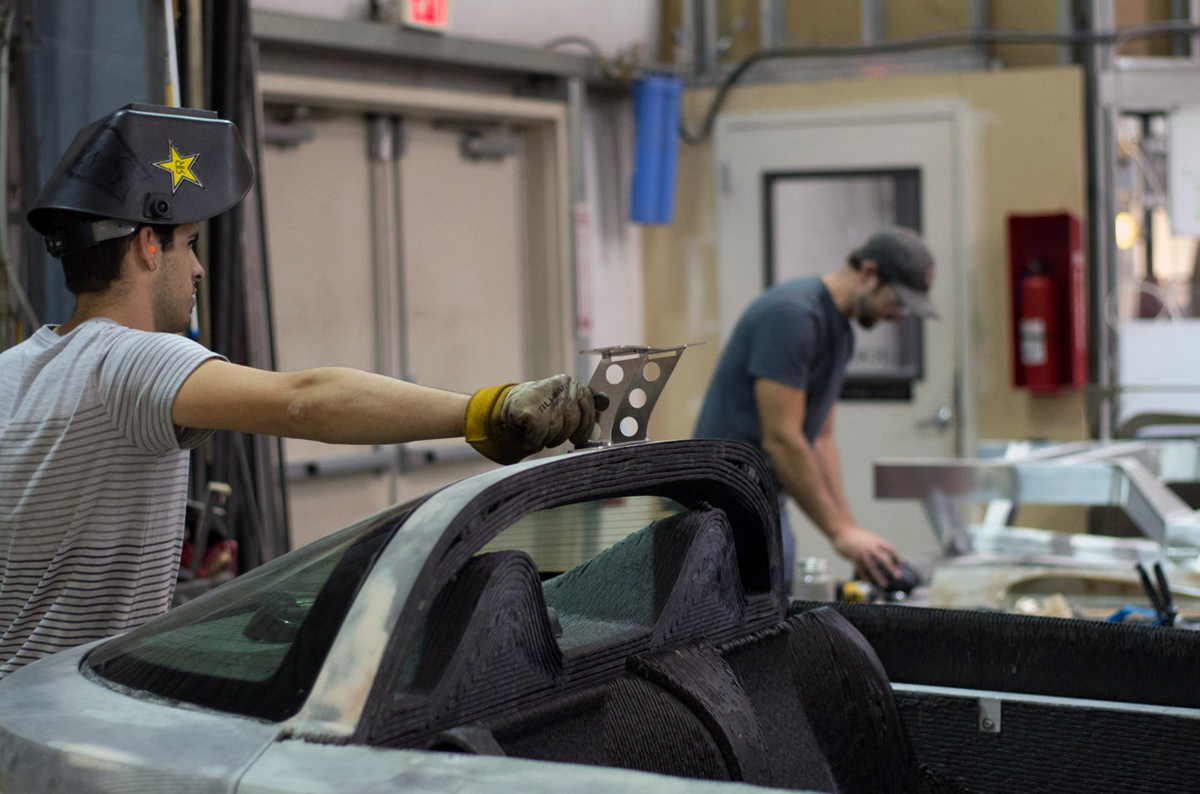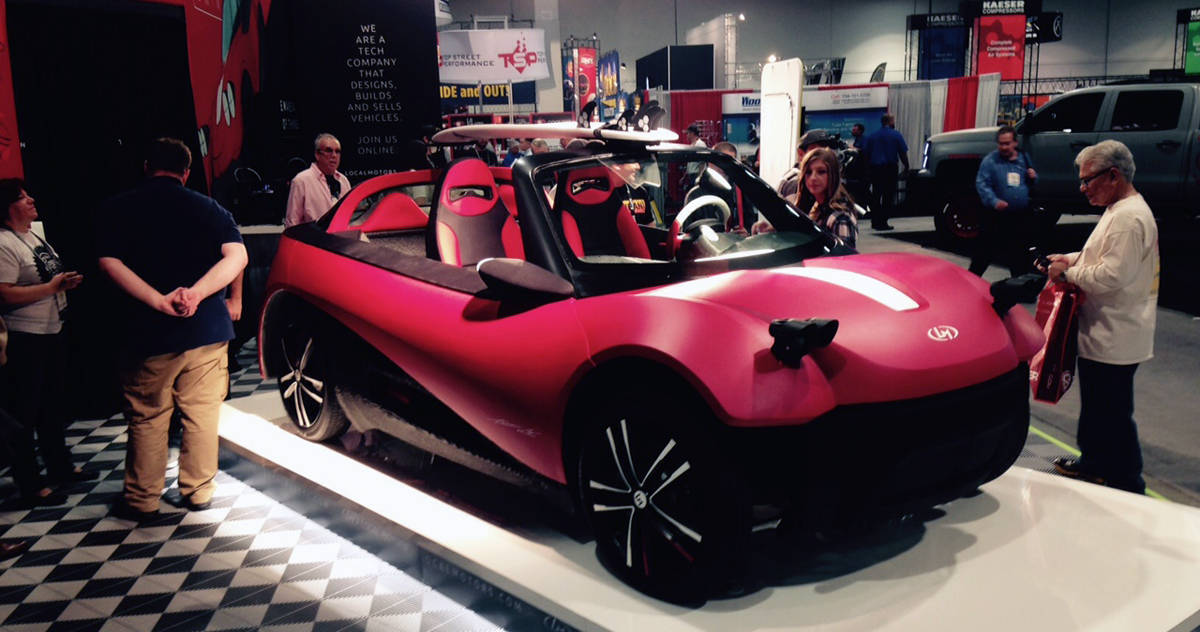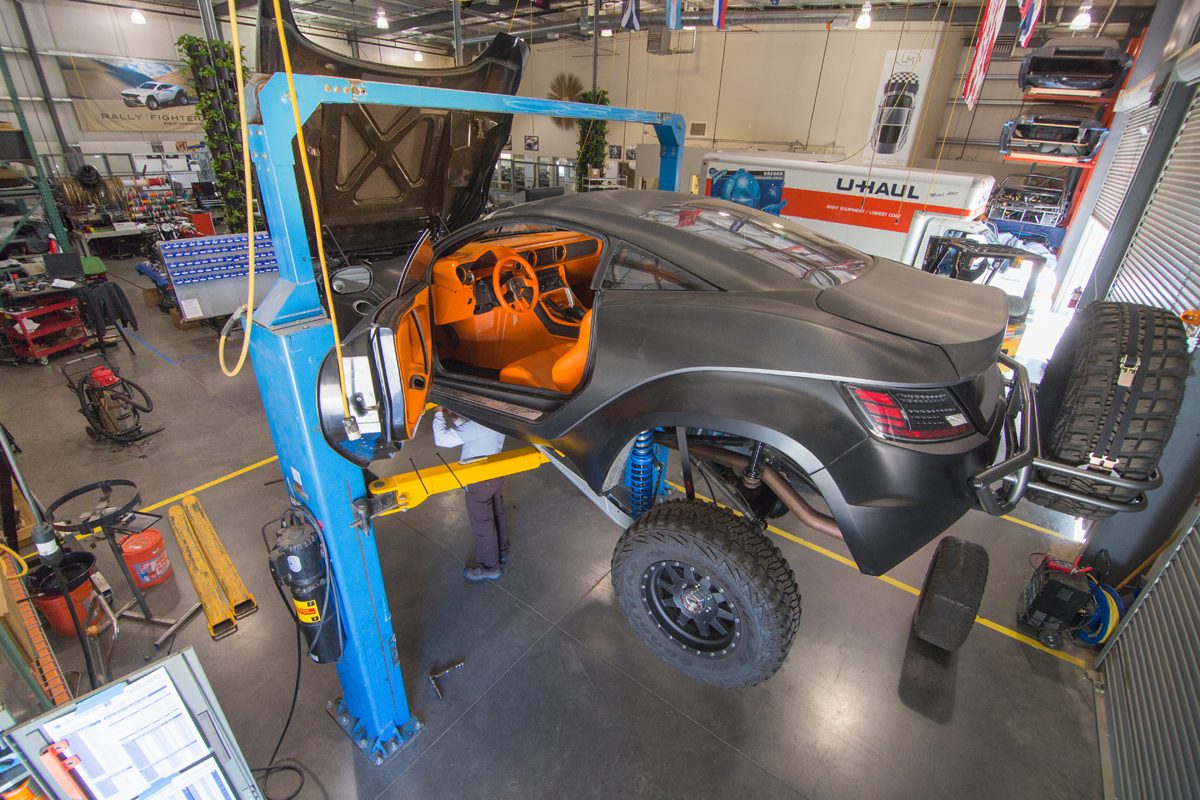At SEMA in Las Vegas, attendees are now being given the opportunity to see what could be an entirely new breed of vehicle, 3D printed and milled by Cincinnati Incorporated and Oak Ridge National Laboratory’s Big Area Additive Manufacturing (BAAM) system and crafted using a digital design sourced from a community of independent artists. The LM3D Swim, designed by Local Motors community member Kevin Lo, will be the first in a series of 3D printed, road-ready vehicles from Local Motors.
After the unveiling from the company, I was able to catch up with the CEO of Local Motors, Jay Rogers, to discuss the LM3D line, the world’s first road-ready, 3D printed vehicle series. In a world in which cars are more reminiscent of covered wagons that spew CO2 than the futuristic sci-fi vehicles of tomorrow, Rogers’ approach to auto manufacturing was refreshing, to say the least. In our brief chat, I learned that, if the auto industry is led by companies like Local Motors, cars may really become “safe, smart, and sustainable”, as their new motto suggests.
It’s difficult to know where to begin in describing a line of vehicles produced by an entirely new method of manufacturing, from crowd sourcing the design to digitally manufacturing the body. So, let’s start with the motor. I learned from Rogers that the LM3D will use an electric motor, which he says that, “since we’re striving for part count reduction and the simplicity of making, a battery electric motor is the right way to go.” Additionally, as the company releases new models throughout 2016 and preps to ship in 2017, the LM3D will likely be released in both the highway-ready model and as a low-speed electric vehicle.

If you compare the LM3D Swim to the company’s first Strati concept car, you’ll notice a significant aesthetic improvement in terms of the refined look of the car. Rogers tells me that any sort of desired detailing can be applied to their vehicles, the same way one would with traditional autos, but with the added benefit of 3D printing and milling. “We can really prep a car any way. We can get it to look refined. We can build shapes. We can mill features and things like that,” Rogers says. “It’s really about what the design calls for. Between the printing, the milling, the polish, and the vinyl wrap, it’s almost unlimited.” In this case, after the LM3D Swim was 3D printed and milled with the BAAM system, it was polished and wrapped with vinyl, giving the LM3D its polished, ruby red appearance.
And, while applying traditional post-processing techniques to a Local Motors car is possible, the digital fabrication method that the company is implementing will cause a definite paradigm shift in how something as advanced as an automobile can be produced, the CEO says, “The benefits to the company, which end up being the benefits to the consumers are: there are no tooling costs associated with a digitally manufactured vehicle. That means that your difficulties of changing up from one model to the next are very, very low. And, so, that’s a huge benefit.”
Rogers elaborates by saying that, without the heavy anchor that is machine tooling, the company is able to be extremely flexible in design and manufacturing, “As battery technology changes, as motors change, as wire harnesses change, as glass changes, as fabrics change, as the materials that you make a car out of change (there are hundreds of thousands of polymers, and additives, and other things that we could use) – not having a tool that you paid tens to hundreds of millions of dollars for means that you can be as flexible as possible to take on the new technology and put it on the next vehicle that comes off the line.” He continues, “That has just never been done. The enormity of that change is so massive that the average consumer just doesn’t understand why it takes five to seven years to change a car model. And that is going to be the advantage that they’re going to receive [with digital manufacturing].”
And it’s this flexibility that will allow the company to really bring the automobile into the 21st century. “The three things about our vehicles is that we want them to be safe, smart, and sustainable,” Rogers says. “The whole thing about them being smart is really a couple of different elements. One is that, today, our vehicles are becoming, slowly, ever-more connected, but they need to be, really, as connected as possible. Think about IBM’s recent acquisition of the Weather Channel. The Weather Channel is a Big Data producer, but we could produce a lot more data on weather from all the cars that are on the road. If we have the right sensors on them, and the right cloud to gather that data, we could do an amazing amount of gathering about local road conditions, instead of atmospheric conditions from 30,000 feet above the road. And, when you have weather data, you could have the car let you know things about what you’re going into and coming out of: freezing conditions, wet conditions, human conditions, fog conversion, things like that.”
He continues, “Then, cognition: the ability to help you plan your route and say, ‘Look, I know you needed to do some shopping and I know you’ve got this weather in front of you. So, you should stop and do those things now, because the weather will pass through and that would be a good time…’ That kind of cognition about what you want to do is a wonderful way to plan.”
These sorts of sensors will be included in the first generation of LM3D cars to hit the road – “There will be sensors, connectivity, and, basically, cloud data storage and collection.” More interestingly, though, is that they can be improved upon when new hardware is made available. Partnering with IBM and other tech companies, Local Motors is going to be able implement new technology in their cars, not with every new line every five to seven years, but with every new car. As developments are made with sensors, for instance, the firm will be able to upgrade the next car off the line. In some ways, this is reminiscent of Google’s Project Ara smartphone, which was meant to use 3D printing to be able to create hardware modules that could be swapped in and out of a phone, as they’re developed and produced. That way, both the software and the hardware can be regularly upgraded, without the need for buying a whole new phone.
Naturally, this will make the cars smarter, but it could also make them safer, according to Rogers. And it may even lead to the foundation for a new type of safety for vehicles. “Everybody wants to know how the 3D printed material fails, survives, and succeeds over time,” the CEO explains. “Our ability to instrument the 3D printed material and then report it back and make it available in real time to the cloud for everybody to write algorithms on, is going to be one of the strongest parts about why an open company is the right kind of company to do this work. So, we’re going to instrument the material so that you’ll be able to actually see it in action. And, then, you’ll be able to get temperature data, GPS data, vibration data, acceleration data. And that’s going to be pretty awesome.”
Having this sort of technology, and this sort of hardware upgradeability that Rogers refers to, means that owning a car will have a completely different sort of vibe. For that reason, it might be difficult to quite imagine right now, but Rogers, I think, can envision it more clearly. He uses the iPhone as an example,“Everybody always talks about market size. I often come back to those days when the Motorola StarTAC was the best phone on the market, at $200, and then Apple came in and said, ‘We’re going to make this thing called a smartphone. And we’re going to charge you $700.’ And people said, ‘There’s no market for a $700 phone. Have you done the market sizing? There’s already a small market for a $200 phone. You’re just going to be taking a piece of that because most people who would buy a $200 phone won’t buy a $700 phone.’ Turns out that they blew the market away with the features that they put in.”
So, yesterday, when we shared our article on Local Motors’ new line of 3D printed cars, readers were shocked by the price tag. After all, who would pay $53k for a car? Excluding those who already pay much more than that for their vehicles, part of the price goes towards owning a completely new kind of car. And the meaning of owning a car will most certainly change. If the LM3D is the iPhone of cars, the coming ecosystem related to that product is hard to predict and the meaning of ownership will certainly change.
The CEO continues, “So, I have this great sense that we’re going to be able to grow the market. Grow the market for people who may not have even had a driver’s license or don’t own a car. I don’t know that the ownership of our cars is going to feel like the same kind of ownership that, when you drive off the lot, it depreciates. What I’d like you to feel like is that you bought into an upgradeable hardware street where it gets better… everyday. It gets better every night. Tesla talks about how your car gets safer every night. I think the hardware should get better every night. I think that, after 12 months or 18 months, you should be able to trade in, recycle your materials, remove your core components, and print out a better, safer, sexier car. And have upgradeable hardware, in addition to upgradeable software.”
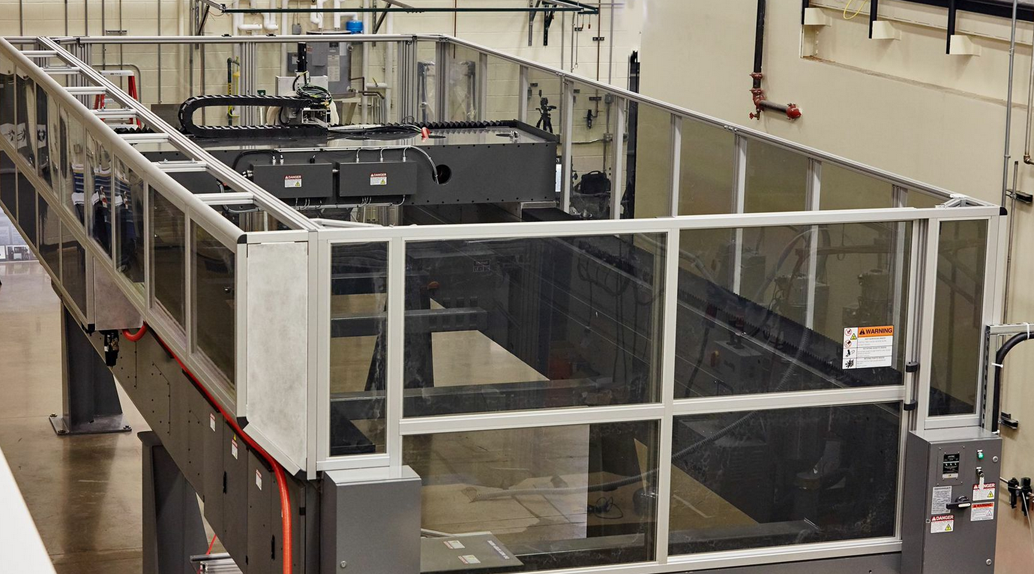
As exciting as the hardware that can be installed, and even the ability to digitally manufacture a car, is, what’s most exciting to me is the open and crowd source nature of Local Motors. Using their Open IO co-creation platform, the Local Motors community brainstorms designs and solutions to problems, while the actual look of the car is chosen through crowd sourcing contests. In this case, the community’s Kevin Lo won an upfront cash prize of $7,500, but, more importantly, he will also receive royalties on every car sold. Though no one will be able to afford the BAAM machine, which is definitely not open source, the open source nature of the vehicles allows the community to implement solutions developed there in their own personal projects.

Those in the 3D printing community know that it’s not so easy to take just any CAD model and convert it into something 3D printable. This is even more true when it comes to turning an aesthetic concept model into a functional automobile. To do this, Local Motors’ product development team relied on what’s called synchronous design, Rogers says. “At a big company, you may have a CAD designer come in and train you on what’s called historical-based CAD and you would basically have to know how a part was built in order to work on it.”
He continues, “But, in the wild and crazy world of the community, where people don’t know the history of the previous parts you’ve been working on, you need non-historical-based models. You need synchronous design – the idea of synchronous or things happening at the same time, where people say ‘I just see what it is and I’m going to start working on it.’ Siemens has a synchronous-based software that we’ve been using, called Solid Edge. We want our community to contribute and our product developers to take what they contribute and make sure that it’s right. So, Siemens’ Solid Edge software was pretty core to making that happen.”
And, now that they’ve been able to transform Lo’s beautiful models into an actual automobile, there’s a long road ahead to bring that auto… well… to the road. The company plans to produce cars at their Sales and Experience Center, soon to be opened in the National Harbor area of D.C., and the micofactory currently under construction in Knoxville, Tennessee – both of which will be open this year. At both locations, Rogers says that they will have five BAAM digital fabrication stations, where they hope to produce two cars per system per day. With 10 cars per day and 270-300 days per year, they think that each factory will make 2,500 to 3,000 units per year.
But, first, they have to get those cars certified. Rogers enlightens me to the certification process, which desperately cries out for some regulatory reform, particularly when you consider GM’s recent, dangerous debacle. “The way that auto certification works in the United States is called Self Certification, which basically means that you raise your hand and then you say that your car is certified,” the CEO says. “That doesn’t mean that someone can’t crash it and then sue you. And then you have to produce all the data that your car was certified under. So, a lot of people don’t understand the self-certification process because they think there’s like the FDA, where the FDA says, ‘I’ve seen your drug. I know that it does what it says that it’s going to do. I’ve seen your process and know that it makes the drug to what it says it’s going to do.’ And the car industry doesn’t have anything like the FDA. And, so, certification is one of those things where all manufacturers are left on their own to do it. So, our process is, you have to take the rules that are written in the Federal Motor Vehicle Safety Standards, Title 49, and you have to go through them.”
Just as 3D printing is transforming the regulations around the medical field, it may do so when it comes to auto manufacturing, as well. “Well, those were written with certain things in mind. Steel cars, different times and capabilities, and, in some cases, our all-composite vehicle will perform, in many ways, much better than what the traditional automotive vehicles are like. And, in other ways, it might be more difficult,” Rogers explains. “So, we’re remaking what it means to certify a vehicle when you change the whole process of making it. Already, that challenge has been well known, if you take the internal combustion engine out of the vehicle and turn it into an electric motor, that really changes the game. There’s just so many things: fire safety, crash safety – both passive and active – user content, user feedback, and things like that.”

This made me wonder if Local Motors’ model isn’t only disrupting manufacturing and regulations, but may be stirring the pot in other areas as well. Tesla’s trouble in selling cars in various states like Michigan and New Jersey came to mind. So far, Rogers says he hasn’t run into any issues with the National Automotive Dealers Association, but that, if he does, he hopes that the old and new guards can work together to spur innovation in the US. “When you’re Local Motors and you’re making locally and you’re selling locally, it really changes the nature of that argument… We should be able to sell locally. We’re really happy that Tesla’s pierced the market in that fight, and we hope that we can join in to help. I don’t think that it needs to be a fight, though. I hope that we’re all in support of innovation.” Rogers concludes, “I hope we’re all in support of local jobs. We’re trying to bring advanced, local manufacturing jobs, which are some of the highest paying jobs in America, and I hope that no one is opposed to those sorts of jobs.”
There were plenty of other questions I had wanted to ask Jay Roger. Like, what does the future of public transportation in a Local Motors world? Or municipally-owned city cars, for that matter. I also wanted to ask him about the safety and privacy issues associated with streaming vehicle data to the cloud. But, I had to let him go, as he had a series of roady-ready 3D printed cars to attend to and I didn’t want to be one more person who was keeping him on the phone for too long. Surely, we’ll hear his thoughts on these topics, as he seems to have already thought of everything, as the new LM3D series preps for the highway. Presales begin next spring. The cars will be shipped in 2017. After that, the future is hard to discern.



